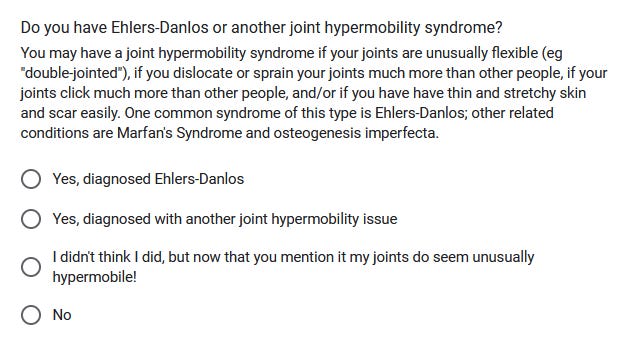Why Do Transgender People Report Hypermobile Joints?
[Related:Why Are Transgender People Immune To Optical Illusions?]
I.
Ehlers-Danlos syndrome is a category of connective tissue disorder; it usually involves stretchy skin and loose, hypermobile joints.
For a few years now, doctors who work with transgender people have commented on an apparently high rate of EDS in this population. For example, Dr. Will Powers, who specializes in hormone therapy, wrote about how he “can’t ignore anymore” that “some sort of hypermobility issue or flat out EDS shows up WAY WAY more than it statistically should” in his transgender patients.
Najafian et al finally counted the incidence in 1363 patients at their gender affirmation surgery (ie sex change) clinic, and found that “the prevalence of EDS diagnosis in our patient population is 132 times the highest reported prevalence in the general population”.
Coming from the other direction, Jones et al, a group of doctors who treat joint disorders in adolescents, found that “17% of the EDS population in our multidisciplinary clinic self-report as [transgender and gender-diverse], which is dramatically higher than the national average of 1.3%”
Why should this be? I know of four and a half theories:
1 ) Spurious result: Although EDS is technically a well-defined disease caused by specific measurable genetic mutations, in practice some cases are just sort of diagnosed on vibes, and the vibes have been getting more popular lately. This doctor calls it an “Instagrammable illness”; this doctor gives an account of EDS patients which stops just short of using the term “special snowflakes”. All Instagrammable conditions cluster together among Instagram users; if transgender is also Instagrammable, that could explain the finding.
Pirate Wires recently reported that transgender and bisexual people were more likely (20 - 25%) to report Long COVID compared to cisgender and straight people (~15%, yes, all these numbers are really high and you shouldn’t exactly believe them). There are lots of possible confounders, and I’ll post a replication attempt from the ACX survey data sometime, but a pretty plausible explanation is that some Long COVID is psychosomatic, all forms of neurodivergence correlate with each other, and so bi and trans people will report more of every psychosomatic condition.
But Long COVID is maximally easy to psych yourself into thinking you have - it’s just fatigue - and Ehlers-Danlos is pretty hard. And Pirate Wires was able to find 1.25x relative risk for bi people and Long COVID, and Najafian found 132x relative risk for trans people and EDS. Also, many trans people are able to easily demonstrate skin/joint abnormalities that are obvious to anyone who looks at them - although it’s possible this is selection bias - a subgroup who have real EDS (at the same rate as cis people) and are very salient because of their gender identity, while cis people with EDS (and trans people with psychosomatic EDS) don’t talk about it as much.
2 ) Estrogen: Women have more EDS (and other joint disorders) than men. They also have looser joints in general. This is mostly because estrogen makes joints more mobile. Maybe there’s something about trans women suddenly taking estrogen after a lifetime of not having estrogen which causes joint problems (or just makes them notice the kinds of minor issues cis women deal with their whole lives).
In contrast to this theory, trans women say they had them even before starting estrogen, and these conditions also seem elevated in trans men.
3 ) Genetics: The gene for congenital adrenal hyperplasia, a sex hormone condition that frequently causes gender divergence, is interwoven on chromosome 6 with the gene for tenascin-X, a joint-related protein whose abnormality causes Ehlers-Danlos syndrome. Maybe if there’s a problem in that part of chromosome 6, you could get both conditions. See here for more discussion.
In contrast to this theory, congenital adrenal hyperplasia is extremely rare, maybe 1/15,000 births among people of European descent. Although many cases of CAH cause gender divergence, most cases of gender divergence cannot be CAH (unless we’re misunderstanding this really badly). CAH can very easily cause biological women to identify as men, but only very very rarely causes biological men to identify as women, whereas the trans-EDS connection seems strong among both genders. Also, there are so many genes involved in everything that I’m skeptical a coincidental alignment of two genes can have much of an effect.
4 ) Autism: There’s an equally mysterious relationship between EDS and autism; autistic people are about 7x more likely to have EDS than controls. This suffers from all the same questions as the transgender link, including the tendency of Instagrammable conditions to correlate together (although in this case it would have to be the parents with Instagram - many of these studies were in very young children). Also, people with autism are about 8x more likely to be gender divergent than the general population. I don’t think anyone knows the exact causal graph here, but it’s at least possible that EDS and transgender are linked because autism is a shared causative factor for both.
My guess is something like joint issues → poor proprioception → all sensory experience is noisy and confusing → the brain, which is embodied and spends most of its time trying to process sensory experience, learns a different reasoning style → different reasoning style is less context-dependent (producing symptoms of autism) → different reasoning style when trying to interpret bodily correlates of gender (eg sex hormones) → transgender.
For more on why I would think this, see here. But also, consider the many reports by autistic people that having weighted blankets, very tight clothing, or other forms of “thing pressing very hard against the skin” alleviates some of their symptoms. Things pressing very hard against the skin are strong proprioceptive feedback! I think of people with proprioceptive disorders as essentially being under negative one weighted blankets at all times.
II.
In order to learn more about this, I asked people about their gender and their joint disorders on the ACX survey, taken by about 7000 people.
All joint conditions are more common among (biological) women, and biological women also relate to gender differently, so to avoid confounding I separated results by biological sex.
Here’s the results for biological men - “M (cisgender)” is coded as cis, “F (transgender f → m)” or “Other” is coded as trans. Total sample size was 5841 cis, 271 trans:
Ehlers-Danlos: 0.36% cis vs. 0.37% trans
Other joint diagnosis: 0.6% cis vs. 1.5% trans
Apparent hypermobility: 4.5% cis vs. 8.1% trans
Ehlers-Danlos was the same, but sample size was completely inadequate - there was only one EDS patient in the trans group. In the other categories, incidence in transgender respondents was about double the average. Chi squared test was marginally significant (p = 0.09) for diagnosed joint issues, and clearly significant (p = 0.01) for any hypermobility.
Here’s the same thing, biological women (n = 765 cis, 91 trans):
Ehlers-Danlos: 1.2% cis vs. 2.2% trans
Other joint diagnosis: 3.4% cis vs. 4.3% trans
Apparent hypermobility: 8.7% cis vs. 10.8% trans
None of these were significant, but again the sample sizes were really tiny.
Was this confounded by autism? Hard to say. I did the same analysis individually in people who didn’t have an autism diagnosis, and then again in people who did have an autism diagnosis, and although the sample sizes were pretty low, a trend was still apparent. But this means nothing; my autism question was binned into do have / don’t have, autism is definitely a spectrum, and it could be that within people who have autism, the people with more severe autism had both more EDS and more gender divergence.
These results were a bit ambiguous, but I think overall they pointed in the direction of replicating the connection. 6/6 trends were in the expected direction, and the first and second largest-sample-size questions were clearly and marginally significant, respectively.
Some ACX survey respondents kindly indicated that I could email them if I had any questions about their responses. I asked some trans people with joint mobility issues to tell me their stories. Here’s a typical response:
[You asked me] in what sense my joints seemed hypermobile:
- The joints between the metacarpals and proximal phalanges on both of my thumbs are able to snap into a position where it bends in the “wrong” direction at will “double jointed”.
- The extensor digitorum tendons on every finger besides my thumb on my left hand, and my middle finger on my right hand, are able to slide off of the knuckle between the metacarpals and proximal phalanges. (I’m not sure if this is strictly joint hypermobility, since the only thing moving is a tendon).
- With the assistance of my other hand, but without any discomfort, I am able to bring the tip of my thumb into contact with the radius.
- Using only the adjoining muscles, I am able to move my tibia out of alignment with the femur and patella on right right leg.
- When either of my arms is fully extended, if I rotate the arm about its own axis, by elbow will often “click.” This is a different sound from people cracking their joints and it doesn’t feel like that either. I don’t really know what this is or if it constitutes joint hypermobility.
I have taken estrogen for twelve months, [but] all the properties of my joints I listed have existed for much longer than I’ve taken estrogen. I was aware of [being double-jointed] at age five, probably earlier. [I didn’t] notice any change in joint hypermobility before vs. after the estrogen.
I think this is some evidence against theory 1 (Instagram special snowflakes). But also, these respondents weren’t people looking for attention. They were people who clicked a box saying “I guess my joints do seem hypermobile” when I specifically asked them about it, on a survey which they were taking for other reasons.
It also argues against theory 2 (supplemental estrogen), since they noticed it long before taking that.
Given that this person is male → female, and congenital adrenal hyperplasia is both very rare and almost always female → male, I don’t think theory 3 looks very good here either.
I continue to find theory 4.5 - a link between proprioception and reasoning styles which sometimes also produces autism - the most convincing.
I’ll probably ask followup questions on next year’s ACX survey where I ask you to try to contort your body in various horrifying ways and tell me how many you can accomplish. Sorry for this in advance.
Speaking of which, thanks to everyone who took the ACX survey - especially our transgender readers, who are heroically patient with me using them as lab rats to test my weird neuroscience theories. As always, you can try to replicate my work using the publicly available ACX Survey Results. If you get slightly different answers than I did, it’s because I’m using the full dataset which includes a few people who didn’t want their answers publicly released. If you get very different answers than I did, it’s because I made a mistake, and you should tell me.

